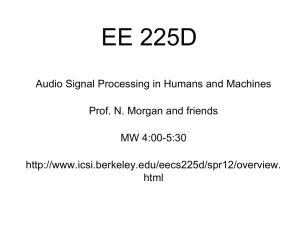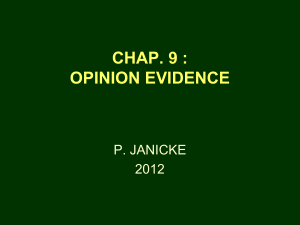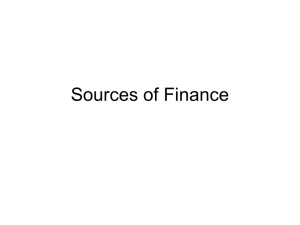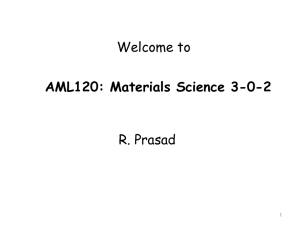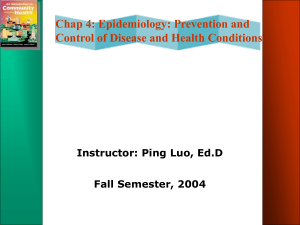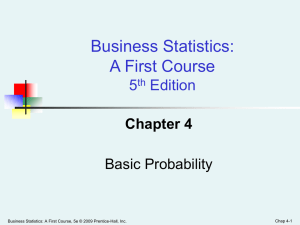Probability
advertisement
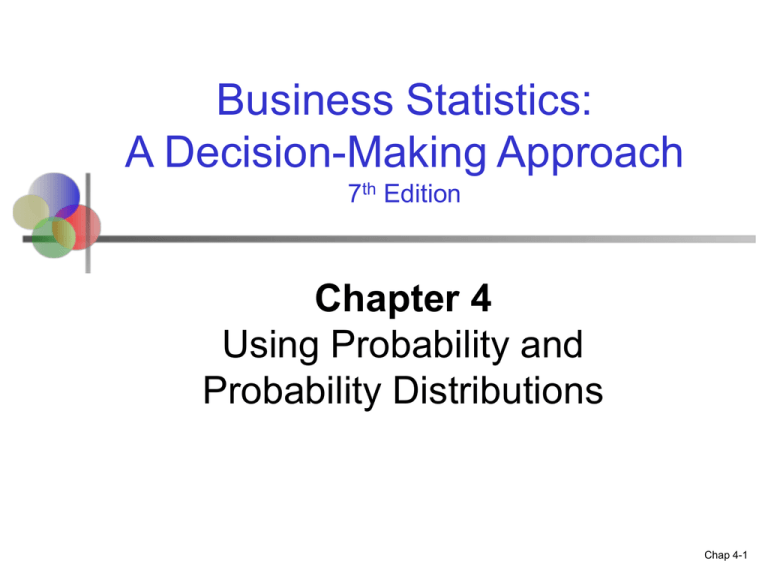
Business Statistics:
A Decision-Making Approach
7th Edition
Chapter 4
Using Probability and
Probability Distributions
Chap 4-1
Important Terms
Random Variable - Represents a possible numerical value
from a random event and it can vary from trial to trial
Probability – the chance that an uncertain event will occur
Experiment – a process that produces outcomes for
uncertain events
Sample Space (or event) – the collection of all possible
experimental outcomes
4-2
Basic Rule of Probability
Individual Values
0 ≤ P(Ei) ≤ 1
For any event Ei
The value of a probability is
between 0 and 1
0 = no chance of occurring
1 = 100% change of occurring
Sum of All Values
k
P(e ) 1
i1
i
where:
k = Number of individual
outcomes in the
sample space
ei = ith individual outcome
The sum of the probabilities of all
the outcomes in a sample space
must = 1 or 100%
4-3
Simple probability
The probability of an event is the number of favorable
outcomes divided by the total number of possible
equally-likely outcomes.
This assumes the outcomes are all equally weighted.
Textbook: classical probability
Chap 4-4
Visualizing Events (or sample space)
Contingency Tables
Ace
Not Ace
Total
Black
2
24
26
Red
2
24
26
Total
4
48
52
Tree Diagrams
2
Sample
Space
Full Deck
of 52 Cards
Sample
Space
24
2
24
Chap 4-5
Experimental Outcome Example
A automobile consultant records fuel type and vehicle
type for a sample of vehicles
2 Fuel types: Gasoline, Diesel
3 Vehicle types: Truck, Car, SUV
6 possible experimental outcomes:
e1
Gasoline, Truck
e2
Gasoline, Car
e3
Gasoline, SUV
e4
Diesel, Truck
e5
Diesel, Car
e6
Diesel, SUV
e1
Car
e2
e3
e4
Car
e5
e6
Chap 4-6
Simple probability
What is the probability that a card drawn at
random from a deck of cards will be an ace?
52 cards in the deck and 4 are aces
The probability is ????
Each card represents a possible outcome 52
possible outcomes.
Chap 4-7
Simple probability
There are 36
possible outcomes
when a pair of dice
is thrown.
Chap 4-8
Simple probability
Calculate the probability that the sum of the two
dice will be equal to 5?
Four of the outcomes have a total of 5: (1,4; 2,3;
3,2; 4,1)
Probability of the two dice adding up to 5 is ????.
Chap 4-9
Simple probability
Calculate the probability that the sum of the
two dice will be equal to 12?
Only one (6,6)
????
Chap 4-10
Simple Probability
The probability of event A is denoted by P(A)
Example: Suppose a coin is flipped 3 times. What is the
probability of getting two tails and one head?
The sample space consists of 8 possible outcomes.
S = {TTT, TTH, THT, THH, HTT, HTH, HHT, HHH}
the probability of getting any particular outcome is 1/8.
Getting two tails and one head: A = {TTH, THT, HTT}
P(A) = ????
Chap 4-11
Essential Concepts and
Rules of Probability
Independent event
Dependent event
Joint and Conditional Probabilities
Mutually Exclusive Event
Addition Rule
Complement Rule
Multiplication Rule
Chap 4-12
Independent vs. Dependent Events
Independent: Occurrence of one does not
influence the probability of
occurrence of the other
Dependent: Occurrence of one affects the
probability of the other
Chap 4-13
Examples
Independent Events
A = heads on one flip of fair coin
B = heads on second flip of same coin
Result of second flip does not depend on the result of
the first flip.
Dependent Events
X = rain forecasted on the news
Y = take umbrella to work
Probability of the second event is affected by the
occurrence of the first event
Chap 4-14
Probability Types
Simple (Marginal) probability
Joint probability
Involves only a single random variable, the outcome of which is
uncertain
Involves two or more random variables, in which the outcome of
all is uncertain
Conditional probability (will be discussed soon!)
Download “Probability Type Example ” Excel file
Chap 4-15
Exercise 4-22-A (page 158)
Download “Computer Use”
Answer for questions using “Pivot Table”
Chap 4-16
Exercise 4-22-B (page 158)
Chap 4-17
Practice
Exercise 4-23: try questions.
Electrical Mechanical
Total
Lincoln
28
39
67
Tyler
64
69
133
Total
92
108
200
Chap 4-18
Conditional Probability: ex 1
A conditional probability is the probability of an event
given that another event has occurred.
Involves two or more random variables, in which the outcome of
at least one is known
Conditional probability for any two events A , B:
P(Aand B)
P(A| B)
P(B)
where P(B) 0
Notation
Chap 4-19
Conditional Probability: ex 1
Of the cars on a used car lot, 70% have air
conditioning (AC) and 40% have a CD player
(CD). 20% of the cars have both.
What is the probability that a car has a CD
player, given that it has AC (use the table on
the next slide)?
i.e., we want to find P(CD | AC)
Chap 4-20
Conditional Probability: ex 1
What is the probability that a car has a CD player, given
that it has AC ?
CD
No CD
Total
AC
.2
.5
.7
No AC
.2
.1
.3
Total
.4
.6
1.0
P(CDand AC) .2
P(CD| AC)
.2857
P(AC)
.7
Chap 4-21
Conditional Probability: ex 2
What is the probability that the total of two
dice will be greater than 8 given that the first
die is a 6?
This can be computed by considering only outcomes
for which the first die is a 6. Then, determine the
proportion of these outcomes that total more than 8.
Chap 4-22
Conditional Probability: ex 2
There are 6 outcomes
for which the first die
is a 6.
And of these, there
are four that total
more than 8.
(6,3; 6,4; 6,5; 6,6)
Chap 4-23
Conditional Probability: ex 2
6 outcomes for which the first die is a 6
There are four that total more than 8
The probability of a total greater than 8 given that the
first die is 6 is 4/6 = 2/3.
More formally, this probability can be written as:
p(total>8 | Die 1 = 6) = 2/3(6,3; 6,4; 6,5; 6,6).
Conditional probability using “Probability Type
Example” Excel file
Chap 4-24
Mutually Exclusive Events
If A occurs, then B cannot occur
A and B have no common elements
A
Black
Cards
B
Red
Cards
A card cannot be
Black and Red at
the same time.
Chap 4-25
Mutually Exclusive Events
If events A and B are mutually exclusive, then the
probability of A or B is p(A or B) = p(A) + p(B)
What is the probability of rolling a die and getting either
a 1 or a 6?
impossible to get both a 1 and a 6
p(1 or 6) = p(1) + p(6) = 1/6 + 1/6 = 1/3
Chap 4-26
Not Mutually Exclusive Events
■
If the events are not mutually exclusive,
P(A or B) = P(A)+ P(B) – P(A and B)
A
+
B
=
A
B
P(A or B) = P(A) + P(B) - P(A and B)
Overlap: joint probability
Chap 4-27
Not Mutually Exclusive Events
What is the probability that a card will be either an ace
or a spade?
p(ace) = 4/52 and p(spade) = 13/52
The only way both can be drawn is to draw the ace of spades.
There is only one ace of spades: p(ace and spade) = 1/52 .
The probability of an ace or a spade can be:
p(ace) + p(spade) - p(ace and spade) =
4/52 + 13/52 - 1/52 = 16/52 = 4/13
Chap 4-28
Rule of Addition
Suppose we have two events and want to know
the probability that either event occurs.
Mutually exclusive:
P(A or B) = P(A) + P(B)
Not Mutually exclusive:
P(A or B) = P(A)+ P(B) – P(A and B)
Chap 4-29
Complement Rule
The complement of an event E is the collection of all
possible elementary events not contained in event E.
The complement of event E is represented by E.
Complement Rule:
P(E) 1 P(E)
Or,
E
P(E) P(E) 1
If there is a 40% ( E ) chance it will rain,
there is a 60% ( E ) chance it won’t rain!
E
Chap 4-30
Rule of Multiplication
The rule of multiplication applies to the situation
when we want to know the probability that both
events (event A and event B) occur.
Addition: either events
Independent: P(A ∩ B) = P(A) P(B)
Dependent: P(A ∩ B) = P(A) P(B|A)
Chap 4-31
Independent Events
If A and B are independent, then the probability that
events A and B both occur is: p(A and B) = p(A) x
p(B)
What is the probability that a coin will come up with
heads twice in a row?
Two events must occur: a head on the first toss and a head
on the second toss.
The probability of each event is 1/2
the probability of both events is: 1/2 x 1/2 = 1/4.
Chap 4-32
Independent Events
What is the probability that the first card is the
ace of clubs (put it back: replace) and the
second card is a club (any club)?
The probability of the first event is 1/52 (only one ace
of club)
The probability of the second event is 13/52 = 1/4
(composed of clubs)
Answer is 1/52 x 1/4 = 1/208
Chap 4-33
Dependent Events
If A and B are not independent, then the
probability of A and B both occur is:
p(A and B) = p(A) x p(B|A)
where p(B|A) is the conditional probability of B
given A.
Chap 4-34
Dependent Events
If someone draws a card at random from a deck and
then, without replacing the first card, draws a second
card, what is the probability that both cards will be
aces?
4 of the 52 cards are aces
First: p(A) = 4/52 = 1/13.
Of the 51 remaining cards, 3 are aces. So, p(B|A)
= 3/51 = 1/17
Probability of A and B is: 1/13 x 1/17 = 1/221.
Chap 4-35
Practice
Page 180
Exercise 4-26
Exercise 4-30
Chap 4-36
Summary
Probability Rules
Addition Rule for Two Events
Addition Rule for Mutually Exclusive Events
Conditional Probability
Multiplication Rules
Chap 4-37
